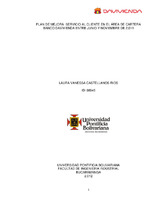| dc.contributor.advisor | Jácome Cabrales, Rubén Darío | |
| dc.contributor.author | Castellanos Ríos, Laura Vanessa | |
| dc.coverage.spatial | Seccional Bucaramanga. Universidad Pontificia Bolivariana. Escuela de Ingenierías. Facultad de Ingeniería Industrial | spa |
| dc.coverage.temporal | 2012 | |
| dc.date.accessioned | 2014-09-10T15:48:04Z | |
| dc.date.available | 2014-09-10T15:48:04Z | |
| dc.date.created | 2012-03-14 | |
| dc.date.issued | 2014-09-10 | |
| dc.identifier.uri | http://hdl.handle.net/20.500.11912/1868 | |
| dc.description | Trabajo de Grado | spa |
| dc.description.abstract | La práctica empresarial se desarrolló en el segundo semestre de 2.011 en el Banco Davivienda sucursal Santander en el área de cartera, entidad que desde su inicio ha buscado exceder las expectativas del consumidor financiero, a través de la prestación de un servicio confiable, oportuno, amable y seguro, que deleite y agregue valor y promueva el mejoramiento continuo de los productos y servicios. El proceso de atención en el área consiste en que por orden de llegada el cliente recibe atención con uno de los dos servidores que conforman cartera, los cuales están preparado para resolver las quejas, reclamos, solicitudes e inquietudes o si es el caso redireccionarlo a otra área. Sin embargo, la incomodidad y ansiedad de los clientes mientras esperan para recibir el servicio es una constante. Por ello se propone analizar el proceso de atención desde la llegada hasta la salida del cliente La metodología planteada para el desarrollo de la práctica consta de cinco fases, la primera es la observación y caracterización del proceso en las 18 transacciones por las que acuden los clientes. La segunda fase es la toma de tiempos de llegadas, de servicio y de salida del usuario. La tercera fase consiste en que por medio de análisis estadístico de prueba de hipótesis para diferencia de medias, se establezcan cuáles son las variables diferenciadoras del proceso. En la cuarta fase se efectúa el funcionamiento actual del proceso de atención del sistema mediante la simulación en el software ARENA, respecto a la segunda fase y los resultados del análisis estadístico de la tercera. La quinta fase consiste en realizar análisis de la problemática por medio del método de la espina de pescado, estableciendo cuáles son las causas raíces generadoras del tiempo en cola de los usuarios del sistema para finalmente proponer soluciones para cada una de las causas y efectuar la simulación del sistema con todas las mejoras establecidas. | spa |
| dc.description.abstract | Business practice was developed in the second part of 2011 in Banco Davivienda, Santander branch in the area of portfolio, company that since its beginning has sought to exceed the expectations of financial consumers through the provision of a reliable, timely, friendly and secure service, to delight and add value that promotes the continuous improvement of products and services.
The process of service in the area is that in order of arrival the customer receives the attention from one of the two servers that make up portfolio, which are prepared to deal with complaints, claims, requests and concerns or if it is necessary, redirect to another area. However, the discomfort and anxiety from the costumers while waiting to receive service is a constant. It is therefore proposed to analyze the process of care from arrival to departure of the customer.
The methodology proposed for the development of practice consists of five phases: the first is the observation and characterization of the process in the 18 transactions that customers usually require. The second phase is taking arrival, service and exit times of the users. The third phase is establishing, through the statistical analysis of hypothesis for mean difference, what are the differentiating variables of the process. In the fourth phase the actual operation of the system is carried through simulation in the ARENA software, in comparison to the second phase and the results of the statistical analysis of the third. The fifth phase involves analysis of the problem by the method of herringbone, to establish the main causes that generate queue time for the system’s users, propose solution for each of the causes and making the simulation of the system with all the enhancements. | |
| dc.language.iso | es | |
| dc.publisher | Universidad Pontificia Bolivariana | spa |
| dc.rights | Attribution-NonCommercial-NoDerivatives 4.0 International | * |
| dc.rights.uri | http://creativecommons.org/licenses/by-nc-nd/4.0/ | * |
| dc.subject | Ingeniería industrial | spa |
| dc.subject | Banco Davivienda | spa |
| dc.subject | Simulación | spa |
| dc.subject | Consumidores | spa |
| dc.subject | Diseño experimental | spa |
| dc.subject | Software de aplicación (Arena) | spa |
| dc.title | Plan de mejora servicio al cliente en el área de cartera banco Davivienda entre junio y noviembre de 2011 | spa |
| dc.type | workingPaper | spa |
| dc.rights.accessRights | openAccess | spa |
| dc.type.hasVersion | publishedVersion | spa |
| dc.identifier.instname | instname:Universidad Pontificia Bolivariana | spa |
| dc.identifier.reponame | reponame:Repositorio Institucional de la Universidad Pontificia Bolivariana | spa |
| dc.identifier.repourl | repourl:https://repository.unab.edu.co/ | |


